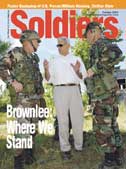IG: Individual discipline failures led to detainee abuse
By Joe Burlas
WASHINGTON (Army News Service, July 22, 2004) -- While there is room for improvement in detainee operations in Iraq and Afghanistan, cases of reported detainee abuse there were caused primarily by individuals failing to live up to the standards of decency and Army Values they had been taught in the Army, according to an Inspector General inspection report made public during recent congressional testimony.
Acting Secretary of the Army Les Brownlee, Army Chief of Staff Gen. Peter Schoomaker and the Army’s top inspector general, Lt. Gen. Paul Mikolashek, briefed members of the Senate Armed Services Committee July 23 on the report’s major findings, observations and recommendations.
“The abuses that occurred are not representative of policy, doctrine or Soldier training,” Mikolashek said. “These abuses should be viewed as what they are -- unauthorized actions taken by a few individuals, and in some cases, coupled with the failure of a few leaders to provide adequate supervision and oversight.”
Brownlee directed the Department of the Army Inspector General on Feb. 10 to conduct an assessment of detainee operations in Iraq and Afghanistan following reports of detainee abuse at Baghdad’s Abu Ghraib prison.
While the inspection reviewed 125 reports of detainee abuse in the Central Command areas of responsibility that were known as of June 9, investigators focused their efforts on a functional analysis of pertinent doctrine, organization, training, materiel, leadership, personnel and facilities issues -- finding no common Army institutional failure among the reported cases.
Of the 125 reports of detainee abuse, 31 were determined to have no substance. Of the 94 remaining cases, some remain undetermined and are under investigation, and some have resulted in criminal charges against involved Soldiers under the Uniform Code of Military Justice.
“Our Soldiers are warriors of character and that will not change,” Schoomaker said. “…The inexcusable actions of a few are not representative of the vast majority of the Army.”
The report noted that detainee abuse does not occur when Soldiers remain disciplined, follow known procedures and understand their obligation to report abusive behavior. Nor does detainee abuse occur when leaders enforce basic standards of humane treatment, provide oversight and supervision of detainee operations and take corrective action when they see potentially abusive situations develop, it stated.
During the course of the inspection, five Soldiers came forward to the IGs to report possible detainee abuse, Mikolashek told the senators. All of those cases were referred to the Criminal Investigation Command, he said.
Other major report findings/observations include:
--Doctrine does not clearly specify the interdependent and independent roles, missions and responsibilities of military police and military intelligence units in the establishment and operation of interrogation facilities.
--While officially approved Combined Joint Task Force 7 and 180 interrogation policies and procedures generally met legal obligations, some were vague and ambiguous. Further, implementation, training and oversight of those policies were inconsistent.
--MI units do not have enough interrogators and interpreters to conduct timely detainee screenings for usable tactical intelligence.
--Tactical MI officers lack the proper training to manage all aspects of the collection and analysis of human intelligence.
--Of the 16 detention facilities inspected in both countries, Abu Ghraib was the only one in an undesirable location, overcrowded and frequently attacked with mortar and rocket fire.
--Some CENTCOM civilian interrogation contractors worked without adequate formal training on military interrogation techniques or policy.
“Just as the current operational environment demands that we adapt, so too we must adapt our organization, doctrine and training -- we are making these adjustments,” Brownlee said.
Acknowledging that one case of detainee abuse is one too many, both Brownlee and Schoomaker asked the senators to put the 125 reported cases of abuse in context of more than 50,000 detainees passing through U.S. military hands, and in some cases, the abuse occurring immediately after the detainee had been trying to kill U.S. forces.
For the purposes of the inspection, detainee abuse was defined as any type of theft, physical assault, sexual assault or death of a detainee.
A copy of the IG final report on its inspection can be downloaded from the features section of the Army homepage, www.army.mil.
|


